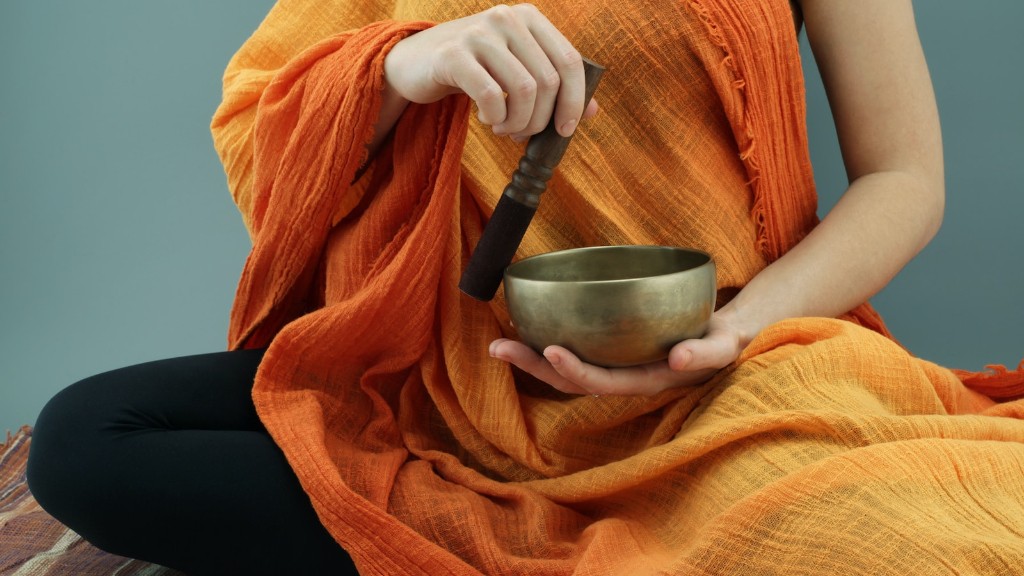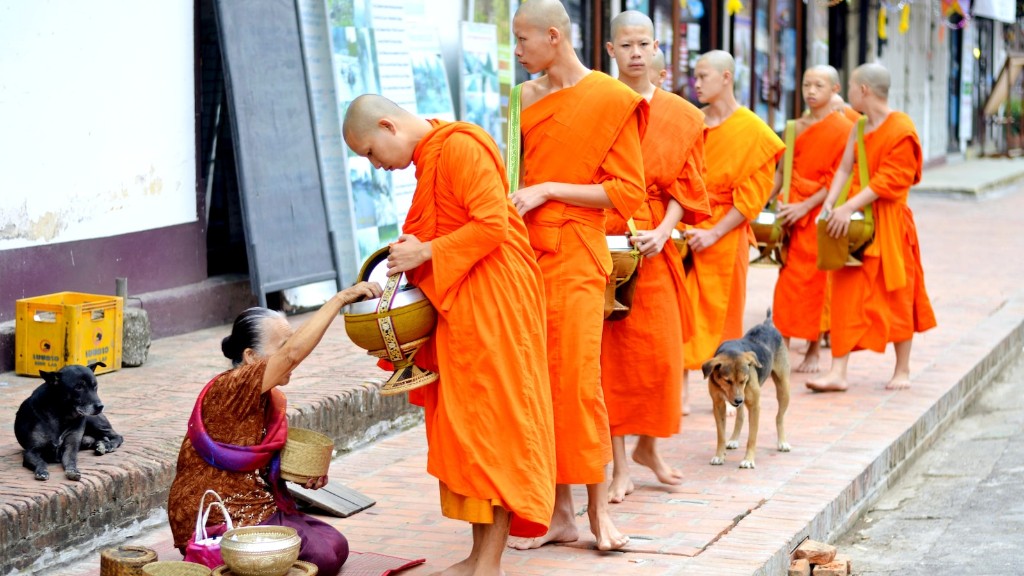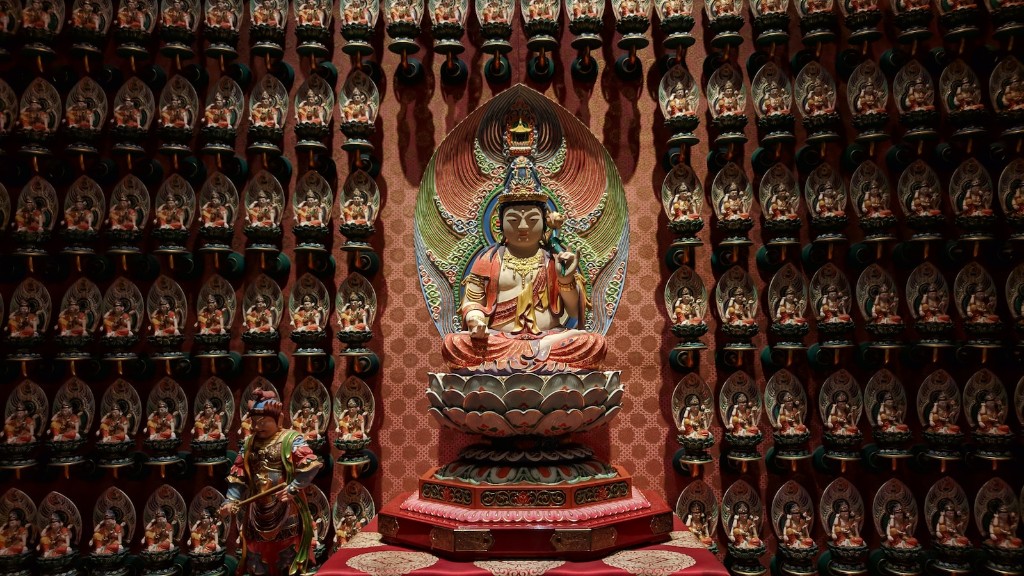Buddhism is a religion that originated in India. It is based on the teachings of Siddhartha Gautama, who was born in the 5th century BCE. Siddhartha Gautama was born into a wealthy family and had everything he could ever want. However, he was not content. He left his home and family to search for the meaning of life. After years of study and meditation, he finally attained enlightenment. He then spent the rest of his life teaching others what he had learned.
Buddhism is a religion of peace and compassion. Buddhists strive to live in harmony with all beings. They believe that all beings have the same basic needs and wants. Therefore, they seek to help others achieve happiness and to avoid suffering.
Buddhists follow the Middle Way, which is the path of moderation. They believe that extremes of self-indulgence and self-mortification are not the way to happiness.
Buddhists also believe in karma, which is the law of cause and effect. They believe that our actions have consequences, both in this life and in future lives. Therefore, Buddhists strive to live in such a way that they will experience positive consequences and to avoid negative
While the specifics of religious practices vary between different Buddhist sects, there are some general practices that are common to most. These include taking refuge in the Three Jewels (the Buddha, the Dharma, and the Sangha), observing the five precepts, participating in puja (worship) ceremonies, chanting mantras, and meditating.
What are the 4 main practices of Buddhism?
The Four Noble Truths are the central teaching of the Buddha. They are:
1. The truth of suffering
2. The truth of the cause of suffering
3. The truth of the end of suffering
4. The truth of the path that leads to the end of suffering.
The Buddha taught that suffering is an inherent part of life and that the root cause of suffering is attachment. He also taught that it is possible to end suffering by following the Noble Eightfold Path.
The Five Precepts are a set of guidelines for living a moral and ethical life. They are:
1. Refrain from taking life
2. Refrain from taking what is not given
3. Refrain from the misuse of the senses
4. Refrain from wrong speech
5. Refrain from intoxicants that cloud the mind.
These precepts provide a framework for living a good life, and help us to avoid causing harm to ourselves and others.
What are the 3 main practices of Buddhism
The three main components of the Buddhist path are śīla, samadhi, and prajna. In order to progress on the path, it is necessary to develop each of these components in turn.
Śīla, or moral conduct, is necessary in order to make one’s body and mind fit for concentration. Samadhi, or meditation, is necessary in order to develop the concentration required to attain a clear vision of the truth. Prajna, or wisdom, is necessary in order to understand the truth that is seen.
It is important to remember that each of these components is interdependent on the others. For example, one cannot develop wisdom without first developing concentration. Similarly, one cannot develop concentration without first developing moral conduct.
Meditation and observance of moral precepts are the foundation of Buddhist practice. The five basic moral precepts are to refrain from taking life, stealing, acting unchastely, speaking falsely, and drinking intoxicants.
What are 2 practices of Buddhism?
Meditation is a key part of Buddhism and is seen as a way to open oneself up to a higher state of awareness. Buddhists may meditate on their own or in groups, and often do so for long periods of time. Bowing is another important part of Buddhism, and Mahayana Buddhists often bow as a sign of respect. Offerings are also made to the Buddha, and these can take the form of gifts or simple offerings of food and water.
East Asian Buddhists constitute the numerically largest body of Buddhist traditions in the world, numbering over half of the world’s Buddhists. East Asian Mahayana began to develop in China during the Han dynasty (when Buddhism was first introduced from Central Asia).
How many practices are there in Buddhism?
Buddhism began in India 2,500 years ago with the Buddha, whose real name was Siddhartha Gautama. Siddhartha was born into a wealthy family, but he gave up his comfortable life to search for the truth about suffering. After years of study and meditation, he finally found the answer: the way to end suffering is to end our attachment to things that are impermanent.
Buddhism quickly spread throughout Asia, and today there are Buddhist communities all over the world. Many people are drawn to Buddhism because it is a non-violent religion that promotes compassion and understanding.
Buddhism is a religion and philosophical system originating in India in the 6th century BCE. The Buddhist tradition considers Siddhartha Gautama to be the Supreme Buddha of our age. Buddhism has had a profound impact on the countries where it is practised, including North Korea, Nepal, India and South Korea. China has the largest population of Buddhists in the world, with approximately 244 million adherents, or 182% of the total population.
What are modern Buddhist practices
Buddhist modernism is a movement that began in the late 19th century as a response to the challenges posed by the modern world. It is characterized by an emphasis on texts, rationality, meditation, egalitarianism, and increased participation of women and laity, along with a deemphasis on ritual, dogma, clerical hierarchy, “superstition,” traditional cosmology, and icon worship.
The goals of Buddhist modernism are to make the teachings of the Buddha more accessible and relevant to modern people, and to create a form of Buddhism that is compatible with the modern world. One of the key figures in the Buddha modernism movement is the Sri Lankan monk Anagarika Dharmapala (1864-1933), who was instrumental in bringing Buddhism to the West and promoting a more liberal, rational approach to the religion.
Buddhist modernism has had a significant impact on the development of Buddhism in the West, and has helped to make it one of the fastest-growing religions in the world today.
“Practice” can also refer to living in accordance with the Buddhist Precepts. To “practice Buddhism” is to live one’s life following the Middle Way, which is the path of moderation between the extremes of luxury and asceticism. “Practice” also refers to the application of the Buddha’s teachings to one’s everyday life.
How do most Buddhists worship?
Buddhists worship at temples or monasteries, where they meditate and pray. Some also set up shrines at home to worship privately. Buddhists offer fresh flowers, lights, and lamps, or burn fragrant incense at shrines with images of the Buddha. These acts pay respect to the Buddha and make merit for the devotee.
The Eightfold Path is a series of eight steps that Buddhists can follow to help them lead a contented (satisfactory) life. The steps are: Right Understanding; Right Thought; Right Speech; Right Action; Right Livelihood; Right Effort; Right Mindfulness; Right Concentration. All of these steps are important in order to lead a contented life. However, each person may place different levels of importance on each step depending on their individual situation.
What is the Buddhist way of life
Buddhism is a religion and philosophy that originated in India in the 6th century BCE. The Buddha, Siddhartha Gautama, was born into a wealthy family and raised in a life of luxury. He later left his life of privilege to seek enlightenment, and after many years of study and meditation, he achieved nirvana. Nirvana is a state of perfect peace and freedom from suffering.
Buddhists follow a strict code of ethics known as the Five Precepts. These precepts are: to refrain from taking life, to refrain from taking what is not given, to refrain from sexual misconduct, to refrain from lying, and to refrain from taking intoxicants. Buddhists also follow the Eightfold Path, which is a set of guidelines for ethical and spiritual living.
Buddhists believe in karma, which is the idea that our actions have consequences, either in this life or in future lives. Good deeds lead to good karma, and bad deeds lead to bad karma. Buddhists also believe in reincarnation, which is the belief that we are reborn into another body after we die.
The goal of Buddhist practice is to achieve nirvana, or perfect peace.
Buddhism is one of the world’s major religions and it started in India around 2,500 years ago. Buddhists do not believe in a god that created everything, but instead they believe in a path to Enlightenment. Siddhartha Gautama became known as the Buddha and he outlined the path to Enlightenment. Buddhism has since spread all over the world and there are many different schools and interpretations of the teachings.
Do Buddhists eat meat?
There are many different interpretations of the Buddhist concept of ahimsa, or non-harming. Many Buddhists interpret this to mean that you should not consume animals, as doing so would require killing. Buddhists with this interpretation usually follow a lacto-vegetarian diet, which means they consume dairy products but exclude eggs, poultry, fish, and meat from their diet.
The Tripitaka is the most sacred scripture of the Theravada school of Buddhism. It is also known as the Pali Canon, after the language in which it was first written down. The Tripitaka consists of three parts: the Vinaya Pitaka (monastic rules), the Sutta Pitaka (Buddhist sermons), and the Abhidhamma Pitaka (philosophical and psychological treatises).
The Tripitaka was first written down in Thailand in the 13th century, and has been translated into many languages. It is the basis of the Theravada tradition, which is followed by the majority of Buddhists in Sri Lanka, Burma, Cambodia, and Laos.
Who are the 3 gods of Buddhism
Vajrapāṇi, Mañjuśrī and Avalokiteśvara are the three major Buddhism deities. They protect the dharma, Buddhist law, and help people achieve nirvana, liberation from the cycle of rebirth.
The Compassion of Buddha is a beautiful mantra that is said to calm fears, soothe concerns, and even mend broken hearts. “Om Mani Padme Hum” translates to “hail to the jewel in the lotus,” and it is a powerful reminder of the buddha’s infinite compassion. If you are ever feeling lost or afraid, remember the Compassion of Buddha and chant this mantra.
Warp Up
There are many religious practices associated with Buddhism, but some of the most important include the following:
-Buddhist monks and nuns typically follow a strict set of rules regarding their behavior and lifestyle. This includes things like wearing simple robes, eating vegetarian meals, and meditating for several hours each day.
-Buddhists often visit temples or shrines to pray and meditate.
-Many Buddhists partake in regular retreats, which typically involve silent meditation and reflection.
-Buddhists may also perform special rituals and ceremonies, such as chanting sutras or making offerings to Buddha statues.
Buddhism has a rich history of religious practices that have evolved over time. The most basic practice is the Four Noble Truths, which teaches that suffering is caused by attachment to false things, that suffering can be ended by letting go of those attachments, and that the path to liberation from suffering is through the Eightfold Path. Other important practices include taking refuge in the Three Jewels (the Buddha, the Dharma, and the Sangha), meditation, and the observance of ethical precepts.


